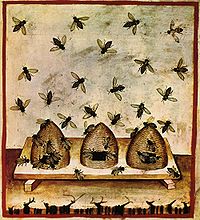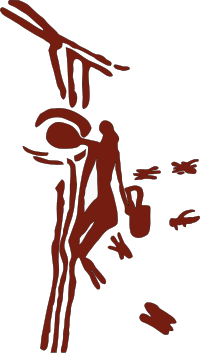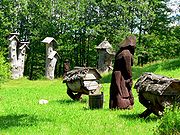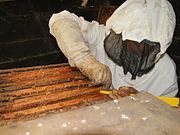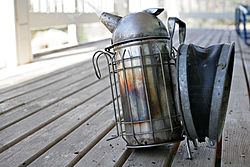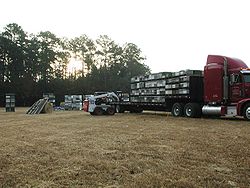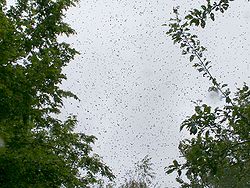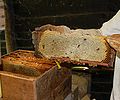
Beekeeping
Background to the schools Wikipedia
SOS Children, which runs nearly 200 sos schools in the developing world, organised this selection. See http://www.soschildren.org/sponsor-a-child to find out about child sponsorship.
Beekeeping (or apiculture, from Latin apis, bee) is the maintenance of honey bee colonies, commonly in hives, by humans. A beekeeper (or apiarist) keeps bees in order to collect honey and beeswax, for the purpose of pollinating crops, or to produce bees for sale to other beekeepers. A location where bees are kept is called an apiary.
History of beekeeping
Origins
Globally, there are more than 20,000 species of wild bees, including many which are solitary or which rear their young in burrows and small colonies, like mason bees and bumblebees. Beekeeping, or apiculture, is concerned with the practical management of the social species of honey bees, which live in large colonies of up to 100,000 individuals. In Europe and America the species universally managed by beekeepers is the Western honey bee (Apis mellifera), which has several sub-species or regional varieties, such as the Italian bee (Apis mellifera ligustica ), European dark bee (Apis mellifera mellifera), and the Carniolan honey bee (Apis mellifera carnica). In the tropics, other species of social bee are managed for honey production, including Apis cerana.
All of the Apis mellifera sub-species are capable of inter-breeding and hybridizing. Many bee breeding companies strive to selectively breed and hybridize varieties to produce desirable qualities: disease and parasite resistance, good honey production, swarming behaviour reduction, prolific breeding, and mild disposition. Some of these hybrids are marketed under specific brand names, such as the Buckfast Bee or Midnite Bee. The advantages of the initial F1 hybrids produced by these crosses include: hybrid vigor, increased honey productivity, and greater disease resistance. The disadvantage is that in subsequent generations these advantages may fade away and hybrids tend to be very defensive and aggressive.
Other bee-breeders are trying to resurrect original native varieties such as the British Black, the French Black or the Danish Black bee on the grounds of preserving biodiversity and producing more gentle bees. This native bee movement is notable in the UK (British Isles Bee Breeding Association; BIBBA), in Ireland (Galtee Bee Breeding Group), and in Denmark.
Wild honey harvesting
Collecting honey from wild bee colonies is one of the most ancient human activities and is still practiced by aboriginal societies in parts of Africa, Asia, Australia, and South America. Some of the earliest evidence of gathering honey from wild colonies is from rock painting, dating to around 13,000 BC. Gathering honey from wild bee colonies is usually done by subduing the bees with smoke and breaking open the tree or rocks where the colony is located, often resulting in the physical destruction of the colony.
Domestication of wild bees
At some point humans began to domesticate wild bees in artificial hives made from hollow logs, wooden boxes, pottery vessels, and woven straw baskets or "skeps." The domestication of bees was well developed in Egypt and sealed pots of honey were found in the grave goods of Pharaohs such as Tutankhamun. Beekeeping was also documented by the Roman writers Virgil, Gaius Julius Hyginus, Varro, and Columella. Aspects of the lives of bees and beekeeping are discussed at length by Aristotle.
Archaeologist Amihai Mazar of Jerusalem's Hebrew University said that findings in the ruins of the city of Rehov (with 2,000 residents at that time, Israelites and Canaanites) include 30 intact hives, 900 B.C., and evidence that an advanced honey industry existed in the Holy Land at the time of the Bible or 3,000 years ago. The beehives -- made of straw and unbaked clay-- were found in orderly rows, with 100 hives. Ezra Marcus, expert of Haifa University, said the finding was a glimpse of ancient beekeeping seen in texts and ancient art from the Near East. Religious practice was evidenced by an altar decorated with fertility figurines found alongside the hives.
The study of honey bees
For several thousand years of human beekeeping, human understanding of the biology and ecology of bees was very limited and riddled with superstition and folklore. Ancient observers thought that the queen bee was in fact a male, called "the king bee," and they had no understanding of how bees actually reproduced. It was not until the 18th century that European natural philosophers undertook the scientific study of bee colonies and began to understand the complex and hidden world of bee biology. Preeminent among these scientific pioneers were Swammerdam, René Antoine Ferchault de Réaumur, Charles Bonnet, and the blind Swiss scientist Francois Huber. Swammerdam and Réaumur were among the first to use a microscope and dissection to understand the internal biology of honey bees. Réaumur was among the first to construct a glass walled observation hive to better observe activities within hives. He observed queens laying eggs in open cells, but still had no idea of how a queen was fertilized; nobody had ever witnessed the mating of a queen and drone and many theories held that queens were "self-fertile," while others believed that a vapor or "miasma" emanating from the drones fertilized queens without direct physical contact. Huber was the first to prove by observation and experiment that queens are physically inseminated by drones outside the confines of hives, usually a great distance away.
Following Réaumur's design, Huber built improved glass-walled observation hives and sectional hives which could be opened, like the leaves of a book, to inspect individual wax combs; this greatly improved the direct observation of activity within a hive. Although he became blind before he was twenty, Huber employed a secretary, Francois Burnens, to make daily observations, conduct careful experiments, and to keep accurate notes over a period of more than twenty years. Huber confirmed that a hive consists of one queen who is the mother of all the female workers and male drones in the colony. He was also the first to confirm that mating with drones takes place outside of hives and that queens are inseminated by a number of successive matings with male drones, high in the air at a great distance from their hive. Together, he and Burnens dissected bees under the microscope and were among the first to describe the ovaries and spermatheca, or sperm store, of queens as well as the penis of male drones. Huber is universally regarded as "the father of modern bee-science" and his "Nouvelles Observations sur Les Abeilles (or "New Observations on Bees, ) revealed all the basic scientific truths for the basics of the biology and ecology of honeybees.
Invention of the moveable comb hive
Early forms of honey collecting entailed the destruction of the entire colony when the honey was harvested. The wild hive was crudely broken into, using smoke to suppress the bees, the honeycombs were torn out and smashed up — along with the eggs, larvae and honey they contained. The liquid honey from the destroyed brood nest was crudely strained through a sieve or basket. This was destructive and unhygienic but for hunter-gatherer societies this did not matter, since the honey was generally consumed immediately and there were always more wild colonies to exploit. However, in settled societies, the destruction of the bee colony meant the loss of a valuable resource; this drawback persisted until the 19th Century, which made beekeeping both inefficient and something of a 'stop and start' activity. There could be no continuity of production and no possibility of selective breeding, since each bee colony was destroyed at harvest time, along with its precious queen. During the medieval period abbeys and monasteries were centers of beekeeping since beeswax was highly prized for candles and fermented honey was used to make alcoholic mead in areas of Europe where vines would not grow.
The 19th Century saw a revolution in beekeeping practice through the invention and perfection of the movable comb hive by Lorenzo Lorraine Langstroth, an Italian immigrant to the United States. Langstroth was the first person to make practical use of Huber's earlier discovery that there was a specific spatial measurement between the wax combs, later called 'the bee space', which bees would not block with wax, but kept as a free passage. Having determined this 'bee space' (between 5 -8 mm), Langstroth then designed a series of wooden frames within a rectangular hive box, carefully maintaining the correct bee space between successive frames, and found that the bees would build parallel honeycombs in the box without bonding them to each other or to the hive walls. This enables the beekeeper to slide any frame out of the hive for inspection, without harming the bees or the comb, protecting the eggs, larvae and pupae contained within the cells. It also meant that combs containing honey could be gently removed and the honey extracted without destroying the comb. The emptied honey combs could then be returned to the bees intact for refilling. Langstroth's classic book, The Hive and Honey-bee, published in 1853, described his rediscovery of the bee space and the development of his patent moveable comb hive.
The invention of the moveable-comb-hive fostered the growth of commercial honey production on a large scale in both Europe and the USA.
Evolution of hive designs
Langstroth's design for moveable comb hives was seized upon by apiarists and inventors on both sides of the Atlantic and a wide range of moveable comb hives were designed and perfected in England, France, Germany and the United States. Classic designs evolved in each country: Dadant hives and Langstroth hives are still dominant in the USA; in France the De-Layens trough-hive became popular and in the UK a British National Hive became standard as late as the 1930s although in Scotland the smaller Smith hive is still popular. In some Scandinavian countries and in Russia the traditional trough hive persisted until late in the 20th Century and is still kept in some areas. However, the Langstroth and Dadant designs remain ubiquitous in the USA and also in many parts of Europe, though Sweden, Denmark, Germany, France and Italy all have their own national hive designs. Regional variations of hive evolved to reflect the climate, floral productivity and the reproductive characteristics of the various subspecies of native honey bee in each bio-region.
The differences in hive dimensions are insignificant in comparison to the common factors in all these hives: they are all square or rectangular; they all use moveable wooden frames; they all consist of a floor, brood-box, honey-super, crown-board and roof. Hives have traditionally been constructed of cedar, pine, or cypress wood, but in recent years hives made from injection molded dense polystyrene have become increasingly important.
Hives also use queen excluders between the brood-box and honey supers to keep the queen from laying eggs in cells next to those containing honey intended for consumption. Also, with the advent in the 20th century of mite pests, hive floors are often replaced for part of (or the whole) year with a wire mesh and removable tray.
Pioneers of practical and commercial beekeeping
The 19th Century produced an explosion of innovators and inventors who perfected the design and production of beehives, systems of management and husbandry, stock improvement by selective breeding, honey extraction and marketing. Preeminent among these innovators were:
L. L. Langstroth, Revered as the "father of American apiculture", no other individual has influenced modern beekeeping practice more than Lorenzo Lorraine Langstroth. His classic book The Hive and Honey-bee was published in 1853.
Moses Quinby, often termed 'the father of commercial beekeeping in the United States', author of Mysteries of Bee-Keeping Explained.
Amos Root, author of the A B C of Bee Culture which has been continuously revised and remains in print to this day. Root pioneered the manufacture of hives and the distribution of bee-packages in the United States.
A.J. Cook, author of The Bee-Keepers' Guide; or Manual of the Apiary, 1876.
Dr. C.C. Miller was one of the first entrepreneurs to actually make a living from apiculture. By 1878 he made beekeeping his sole business activity. His book, Fifty Years Among the Bees, remains a classic and his influence on bee management persists to this day.
Major Francesco De Hruschka was an Italian military officer who made one crucial invention that catalyzed the commercial honey industry. In 1865 he invented a simple machine for extracting honey from the comb by means of centrifugal force. His original idea was simply to support the comb in a metal framework and then spin it around within a container to collect the honey as it was thrown out by centrifugal force. This meant that honeycombs could be returned to the hive undamaged but empty — saving the bees a vast amount of work, time and materials. This single invention greatly improved the efficiency of honey harvesting and catalysed the modern honey industry.
Traditional beekeeping
Fixed frame hives
There are considerable regional variations in the type of hive in which bees are kept. A hive is a set of rectangular wooden boxes filled with moveable wood or plastic frames, each of which holds a sheet of wax or plastic foundation. The bees build cells upon the sheets of foundation to create complete honeycombs. Foundation comes in two cell-sizes: worker foundation, which enables the bees to create small, hexagonal worker cells; and drone foundation, which allows the bees to build much larger drone cells, for the production of male bees.
The bottom box, or brood chamber, contains the queen and most of the bees; the upper boxes, or supers, contain just honey. Only the young nurse bees can produce wax flakes which they secrete from between their abdominal plates; they build honeycomb using the artificial wax foundation as a starting point, after which they may raise brood or deposit honey and pollen in the cells of the comb. These frames can be freely manipulated and honey supers with frames full of honey can be taken and extracted for their honey crop.
Modern beekeeping
Movable frame hives
In the USA, the Langstroth hive is commonly used. The Langstroth was the first successful top-opened hive with movable frames, and other designs of hive have been based on it. Langstroth hive was however a descendant of Jan Dzierzon’s Polish hive designs. In the United Kingdom, the most common type of hive is the British National Hive, but it is not unusual to see some other sorts of hive (Smith, Commercial and WBC, rarely Langstroth). Straw skeps, bee gums, and unframed box hives are now unlawful in most US states, as the comb and brood cannot be inspected for diseases. However, straw skeps are still used for collecting swarms by hobbyists in the UK, before moving them into standard hives.
Top bar hives
A few hobby beekeepers are adopting various top bar hives of the type commonly found in Africa. These have no frames and the honey filled comb is not returned to the hive after extraction, as it is in the Langstroth hive. Because of this, the production of honey in a top bar hive is only about 20% that of a Langstroth hive, but the initial costs and equipment requirements are far lower. Top-bar hives also offer some advantages in interacting with the bees and the amount of weight that must be lifted is greatly reduced. Top Bar Hives are being widely used in developing countries in Africa and Asia as a result of the 'Bees For Development' program.
Protective clothing
While knowledge of the bees is the first line of defense, most beekeepers also wear some protective clothing. Novice beekeepers usually wear gloves and a hooded suit or hat and veil. Experienced beekeepers sometimes elect not to use gloves because they inhibit delicate manipulations. The face and neck are the most important areas to protect, so most beekeepers will at least wear a veil.
Defensive bees are attracted to the breath, and a sting on the face can lead to much more pain and swelling than a sting elsewhere, while a sting on a bare hand can usually be quickly removed by fingernail scrape to reduce the amount of venom injected.
The protective clothing is generally light coloured (but not colourful) and of a smooth material. This provides the maximum differentiation from the colony's natural predators (bears, skunks, etc.) which tend to be dark-colored and furry.
Smoker
Smoke is the beekeeper's third line of defense. Most beekeepers use a "smoker" — a device designed to generate smoke from the incomplete combustion of various fuels. Smoke calms bees; it initiates a feeding response in anticipation of possible hive abandonment due to fire. Smoke also masks alarm pheromones released by guard bees or when bees are squashed in an inspection. The ensuing confusion creates an opportunity for the beekeeper to open the hive and work without triggering a defensive reaction. In addition, when a bee consumes honey the bee's abdomen distends, supposedly making it difficult to make the necessary flexes to sting, though this has not been tested scientifically.
Smoke is of questionable use with a swarm, because swarms do not have honey stores to feed on in response. Usually smoke is not needed, since swarms tend to be less defensive, as they have no stores to defend, and a fresh swarm will have fed well from the hive.
Many types of fuel can be used in a smoker as long as it is natural and not contaminated with harmful substances. These fuels include hessian, pine needles, corrugated cardboard, and mostly rotten or punky wood. Some beekeeping supply sources also sell commercial fuels like pulped paper and compressed cotton, or even aerosol cans of smoke.
Some bee keepers are using "liquid smoke" as a safer, more convenient, alternative. It is a water-based solution that is sprayed onto the bees from a plastic spray bottle.
Beekeeping in the United States
Development of beekeeping in the United States
John Harbison, originally from Pennsylvania, successfully brought bee keeping to the US west coast in the 1860s, in an area now known as Harbison Canyon, California, and greatly expanded the market for honey throughout the country.
Beekeeping was traditionally practiced for the bees' honey harvest, although nowadays crop pollination service can often provide a greater part of a commercial beekeeper's income. Other hive products are pollen, royal jelly, and propolis, which are also used for nutritional and medicinal purposes, and beeswax, which is used in candle making, cosmetics, wood polish, and for modelling. The modern use of hive products has changed little since ancient times.
Western honey bees are not native to the Americas. American, Australian, and New Zealand colonists imported honey bees from Europe, partly for honey and partly for their usefulness as pollinators. The first honey bee species imported were likely European dark bees. Later Italian bees, Carniolan honey bees and Caucasian bees were added.
Western honey bees were also brought to the Primorsky Krai in Russia by Ukrainian settlers around 1850s. These Russian honey bees that are similar to the Carniolan bee were imported into the U.S. in 1990. The Russian honey bee has shown to be more resistant to the bee parasites Varroa destructor and Acarapis woodi.
Before the 1980s, most U.S. hobby beekeepers were farmers or relatives of a farmer, lived in rural areas, and kept bees with techniques passed down for generations. The arrival of tracheal mites in the 1980s and varroa mites and small hive beetles in the 1990s led to the discontinuation of the practice by most of these beekeepers as their bees could not survive among these new parasites.
In Asia, other species of Apis exist which are used by local beekeepers for honey and beeswax. Non-Apis species of honey bees, known collectively as melipolines or stingless bees, have also been kept from antiquity in Australia and Central America, although these traditions are dying, and some of the meliponine species used are endangered.
Types of beekeepers
Beekeepers generally categorize themselves as:
- Commercial beekeeper — Beekeeping is the primary source of income.
- Sideliner — Beekeeping is a secondary source of income.
- Hobbyist — Beekeeping is not a significant source of income.
Some southern U.S. and southern hemisphere (New Zealand) beekeepers keep bees primarily to raise queens and package bees for sale. In the U.S., northern beekeepers can buy early spring queens and 3- or 4-pound packages of live worker bees from the South to replenish hives that die out during the winter, although this is becoming less practical due to the spread of the Africanized bee.
In cold climates commercial beekeepers have to migrate with the seasons, hauling their hives on trucks to gentler southern climates for better wintering and early spring build-up. Many make "nucs" (small starter or nucleus colonies) for sale or replenishment of their own losses during the early spring. In the U.S. some may pollinate squash or cucumbers in Florida or make early honey from citrus groves in Florida, Texas or California. The largest demand for pollination comes from the almond groves in California. As spring moves northward so do the beekeepers, to supply bees for tree fruits, blueberries, strawberries, cranberries and later vegetables. Some commercial beekeepers alternate between pollination service and honey production but usually cannot do both at the same time.
In the Northern Hemisphere, beekeepers may harvest honey from July until October, according to the honey flows in their area. Good management requires keeping the hive free of pests and disease, and ensuring that the bee colony has room in the hive to expand. Chemical treatments, if used for parasite control, must be done in the off-season to avoid any honey contamination. Success for the hobbyist also depends on locating the apiary so bees have a good nectar source and pollen source throughout the year.
In the Southern Hemisphere, beekeeping is an all-the-year-round enterprise, although in cooler areas (to the south of Australia and New Zealand) the activity may be minimal in the winter (May to August). Consequently, the movement of commercial hives is more localized in these areas.
Bee rentals and migratory beekeeping
After the winter of 1907, US beekeeper Nephi Miller decided to try moving his hives to different areas of the country to increase their productivity during winter. Since then, "migratory beekeeping" has become widespread in America. It is a crucial element of US agriculture, which could not produce anywhere near its current levels with native pollinators alone. Beekeepers earn much more from renting their bees out for pollination than they do from honey production.
One major US beekeeper reports moving his hives from Idaho to California in January to prepare for almond pollination in February, then to apple orchards in Washington in March, to North Dakota two months later for honey production, and then back to Idaho by November — a journey of several thousands of miles. Others move from Florida to New Hampshire or to Texas. About two thirds of US domestic bees visit California for the almond bloom in February.
Keepers in Europe and Asia are generally far less mobile, with bee populations moving and mingling within a smaller geographic extent (although some keepers do move longer distances, it is much less common). This wider spread and intermingling in the US has resulted in far greater losses from Varroa mite infections in recent years.
Bee colonies
Castes
A colony of bees consists of three castes of bee:
- a queen, which is normally the only breeding female in the colony;
- a large number of female worker bees, typically 30,000–50,000 in number;
- a number of male drones, ranging from thousands in a strong hive in spring to very few during dearth or cold season.
The queen is the only sexually mature female in the hive and all of the female worker bees and male drones are her offspring. The queen may live for up to three years or more and may be capable of laying half a million eggs or more in her lifetime. At the peak of the breeding season, late spring to summer, a good queen may be capable of laying 3,000 eggs in one day, more than her own body weight. This would be exceptional however; a prolific queen might peak at 2,000 eggs a day, but a more average queen might lay just 1500 eggs per day. The queen is raised from a normal worker egg, but is fed a larger amount of royal jelly than a normal worker bee, resulting in a radically different growth and metamorphosis. The queen influences the colony by the production and dissemination of a variety of pheromones or 'queen substances'. One of these chemicals suppresses the development of ovaries in all the female worker bees in the hive and prevents them laying eggs.
Mating of queens
The queen emerges from her cell after 15 days of development and she remains in the hive for 3-7 days before venturing out on a mating flight. Her first orientation flight may only last a few seconds, just enough to mark the position of the hive. Subsequent mating flights may last from 5 minutes to 30 minutes, and she may mate with a number of male drones on each flight. Over several matings, possibly a dozen or more, the queen will receive and store enough sperm from a succession of drones to fertilize hundreds of thousands of eggs. If she does not manage to leave the hive to mate — possibly due to bad weather or being trapped within part of the hive — she will remain infertile and become a 'drone layer', incapable of producing female worker bees, and the hive is doomed.
Mating takes place at some distance from the hive and often several hundred feet up in the air; it is thought that this separates the strongest drones from the weaker ones - ensuring that only the fastest and strongest drones get to pass on their genes.
Fertilized and non-fertilized eggs
Having achieved a successful mating, the queen will begin to lay eggs for the first time a few days later. The vast majority of eggs she lays will be fertilized eggs and will produce female worker bees. If she lays an unfertilized egg it will develop into a male drone. How the colony decides how many workers will be raised versus how many drones will be raised is not fully understood.
Female worker bees
Almost all the bees in a hive are female worker bees. At the height of summer when activity in the hive is frantic and work goes on non-stop, the life of a worker bee may be as short as 6 weeks; in late autumn, when no brood is being raised and no nectar is being harvested, a young bee may live for 16 weeks, right through the winter. During its life a worker bee performs different work functions in the hive which are largely dictated by the age of the bee.
| Period | Work activity |
|---|---|
| Days 1-3 | Cleaning cells and incubation |
| Day 3-6 | Feeding older larvae |
| Day 6-10 | Feeding younger larvae |
| Day 8-16 | Receiving honey and pollen from field bees |
| Day 12-18 | Wax making and cell building |
| Day 14 onwards | Entrance guards; nectar and pollen foraging |
Male bees (drones)
Drones are the largest bees in the hive at almost three times the size of a worker bee. They do no work, do not forage for pollen or nectar and are only produced in order to mate with new queens and fertilize them on their mating flights. A bee colony will generally start to raise drones a few weeks before building queen cells in order to supersede a failing queen or in preparation for swarming. When queen raising for the season is over, the bees in colder climates will drive the drones out of the hive to die, biting and tearing at their legs and wings; the drones have become a useless burden on the colony which can no longer be tolerated.
Differing stages of development
| Stage of development | Queen | Worker | Drone |
|---|---|---|---|
| Egg | 3 days | 3 days | 3 days |
| Larva | 8 days | 10 days | 13 days |
| Pupa | 4 days | 8 days | 8 days |
| Total | 15 days | 21 days | 24 days |
Structure of a bee colony
A domesticated bee colony is normally housed in a rectangular hive body, within which ten or twelve parallel frames house the vertical plates of honeycomb which contain the eggs, larvae, pupae and food for the colony. If one were to cut a vertical cross-section through the hive from side to side, the brood nest would appear as a roughly ovoid ball spanning 5-8 frames of comb. The two outside combs at each side of the hive tend to be exclusively used for long-term storage of honey and pollen.
Within the central brood nest, a single frame of comb will typically have a central disk of eggs, larvae and sealed brood cells which may extend almost to the edges of the frame. Immediately above the brood patch an arch of pollen-filled cells extends from side to side, and above that again a broader arch of honey-filled cells extends to the frame tops. The pollen is protein-rich food for developing larvae, while honey is also food but largely energy rich rather than protein rich. The nurse bees which care for the developing brood secrete a special food called 'royal jelly' after feeding themselves on honey and pollen. The amount of royal jelly which is fed to a larva determines whether it will develop into a worker bee or a queen.
Apart from the honey stored within the central brood frames, the bees store surplus honey in combs above the brood nest. In modern hives the beekeeper places separate boxes, called 'supers', above the brood box, in which a series of shallower combs is provided for storage of honey. This enables the beekeeper to remove some of the supers in the late summer, and to extract the surplus honey harvest, without damaging the colony of bees and its brood nest below. If all the honey is 'stolen', including the amount of honey needed to survive winter, the beekeeper must replace these stores by feeding the bees sugar or corn syrup in autumn.
Annual cycle of a bee colony
The development of a bee colony follows an annual cycle of growth which begins in spring with a rapid expansion of the brood nest, as soon as pollen is available for feeding larvae. Some production of brood may begin as early as January, even in a cold winter, but breeding accelerates towards a peak in May (in the northern hemisphere), producing an abundance of harvesting bees synchronised to the main 'nectar flow' in that region. Each race of bees times this build-up slightly differently, depending on how the flora of its original region blooms. Some regions of Europe have two nectar flows: one in late spring and another in late August. Other regions have only a single nectar flow. The skill of the beekeeper lies in predicting when the nectar flow will occur in his area and in trying to ensure that his colonies achieve a maximum population of harvesters at exactly the right time.
The key factor in this is the prevention, or skillful management of the swarming impulse. If a colony swarms unexpectedly and the beekeeper does not manage to capture the resulting swarm, he is likely to harvest significantly less honey from that hive, since he will have lost half his worker bees at a single stroke. If, however, he can use the swarming impulse to breed a new queen but keep all the bees in the colony together, he will maximize his chances of a good harvest. It takes many years of learning and experience to be able to manage all these aspects successfully, though owing to variable circumstances many beginners will often achieve a good honey harvest.
Formation of new colonies
Colony reproduction; swarming and supersedure
All colonies are totally dependent on their queen, who is the only egg-layer. However, even the best queens live only a few years and one or two years longevity is the norm. She can choose whether or not to fertilize an egg as she lays it; if she does so, it develops into a female worker bee; if she lays an unfertilized egg it becomes a male drone. She decides which type of egg to lay depending on the size of the open brood cell which she encounters on the comb; in a small worker cell she lays a fertilized egg; if she finds a much larger drone cell she lays an unfertilized drone egg.
All the time that the queen is fertile and laying eggs she produces a variety of pheromones which control the behaviour of the bees in the hive; these are commonly called 'queen substance' but in reality there are various different pheromones with different functions. As the queen ages she begins to run out of stored sperm and her pheromones begin to fail. At some point, inevitably, the queen begins to falter and the bees will decide to replace her by creating a new queen from one of her worker eggs. They may do this because she has been damaged (lost a leg or an antenna), because she has run out of sperm and cannot lay fertilized eggs (has become a 'drone laying queen') or because her pheromones have dwindled to a point where they cannot control all the bees in the hive anymore.
At this juncture the bees will produce one or more queen cells by modifying existing worker cells which contain a normal female egg. However, there are two distinct behaviors which the bees pursue:
- Supersedure: queen replacement within one hive without swarming
- Swarm cell production: the division of the hive into two colonies by swarming
Different sub-species of Apis mellifera exhibit differing swarming characteristics which reflect their evolution in different ecotopes of the European continent. In general the more northerly black races are said to swarm less and supersede more, whereas the more southerly yellow and grey varieties are said to swarm more frequently. The truth is complicated because of the prevalence of cross-breeding and hybridization of the sub species and opinions differ.
Supersedure is highly valued as a behavioral trait by beekeepers because a hive that supersedes its old queen does not swarm and so no stock is lost; it merely creates a new queen and allows the old one to fade away, or alternatively she is killed when the new queen emerges. When superseding a queen the bees will produce just one or two queen cells, characteristically in the centre of the face of a broodcomb.
In swarming, by contrast, a great many queen cells are created — typically a dozen or more — and these are located around the edges of a broodcomb, most often at the sides and the bottom.
Once either process has begun, the old queen will normally leave the hive with the hatching of the first queen cells. When she leaves the hive the old queen is accompanied by a large number of bees, predominantly young bees (wax-secreters), who will form the basis of the new hive. Scouts are sent out from the swarm to find suitable hollow trees or rock crevices and as soon as one is found the entire swarm moves in, building new wax brood combs within a matter of hours using the honey stores which the young bees have filled themselves with before leaving the old hive. Only young bees can secrete wax from special abdominal segments and this is why there tends to be more young bees than old in swarms. Often a number of virgin queens accompany the first swarm (the 'prime swarm'), and the old queen is replaced as soon as a daughter queen is mated and laying. Otherwise, she will be quickly superseded in their new home.
Factors that trigger swarming
It is generally accepted that a colony of bees will not swarm until it has completed all its brood combs, i.e. filled all available space with eggs, larvae and brood. This generally occurs in late Spring at a time when the other areas of the hive are rapidly filling with honey stores. So one key trigger of the swarming instinct is when the queen has no more room to lay eggs and the hive population is becoming very congested. Under these conditions a prime swarm may issue with the queen, resulting in a halving of the population within the hive and leaving the old colony with a large amount of hatching bees. The queen who leaves finds herself in a new hive with no eggs, no larvae but lots of energetic young bees who create a new set of brood combs from scratch in a very short time.
Another important factor in swarming is the age of the queen. Those under a year in age are unlikely to swarm unless they are extremely crowded, while older queens are much more predispositioned to swarm.
Beekeepers monitor their colonies carefully in spring and watch for the appearance of queen cells, which are a dramatic signal that the colony is determined to swarm.
When a colony has decided to swarm, queen cells are produced in numbers varying to a dozen or more. When the first of these queen cells is sealed, after 8 days of larval feeding, a virgin queen will pupate and be due to emerge seven days after sealing. Before leaving, the worker bees fill their stomachs with honey in preparation for the creation of new honeycombs in a new home. This cargo of honey also makes swarming bees less inclined to sting and a newly issued swarm is noticeably gentle for up to 24 hours — often capable of being handled without gloves or veil by a beekeeper.
This swarm is looking for shelter. A beekeeper may capture it and introduces it into a new hive helping to meet this need. Otherwise, it will return to a feral state, in which case it will find shelter in a hollow tree, an excavation, an abandoned chimney or even behind shutters.
Back at the original hive, the first virgin queen to emerge from her cell will immediately seek out to kill all her rival queens who are still waiting to emerge from their cells. However, usually the bees deliberately prevent her from doing this, in which case, she too will lead a second swarm from the hive. Successive swarms are called 'after-swarms' or 'casts' and can be very small, often with just a thousand or so bees, as opposed to a prime swarm which may contain as many as ten to twenty thousand bees.
Small after-swarms have less chance of survival and may deplete the original hive threatening its survival as well. When a hive has swarmed despite the beekeeper's preventative efforts, a good management practice is to give the depleted hive a couple frames of open brood with eggs. This helps replenish the hive more quickly, and gives a second opportunity to raise a queen, if there is a mating failure.
Each race or sub-species of honeybee has its own swarming characteristics. Italian bees are very prolific and inclined to swarm; Northern European black bees have a strong tendency to supersede their old queen, without swarming. These differences are the result of differing evolutionary pressures in the regions where each sub-species evolved.
Artificial swarming
When a colony accidentally loses its queen, it is said to be 'queenless'. The workers realize that the queen is absent after as little as an hour, as her pheromones fade in the hive. The colony cannot survive without a fertile queen laying eggs to renew the population. So the workers select cells containing eggs aged less than three days and enlarge these cells dramatically to form 'emergency queen cells'. These appear similar to large peanut-like structure about an inch long, which hangs from the centre or side of the brood combs. The developing larva in a queen cell is fed differently from an ordinary worker-bee, receiving in addition to the normal honey and pollen a great deal of royal jelly, a special food secreted by young 'nurse bees' from the hypopharyngeal gland. This special food dramatically alters the growth and development of the larva so that, after metamorphosis and pupation, it emerges from the cell as a queen bee. The queen is the only bee in a colony which has fully developed ovaries and she secretes a pheromone which suppresses the normal development of ovaries in all her worker-daughters.
Beekeepers use the ability of the bees to produce new queens in order to increase their colonies, a procedure called splitting a colony. In order to do this, they remove several brood combs from a healthy hive, taking care that the old queen is left behind. These combs must contain eggs or larvae less than three days old which will be covered by young 'nurse bees' which care for the brood and keep it warm. These brood combs and attendant nurse bees are then placed into a small 'nucleus hive' along with other combs containing honey and pollen. As soon as the nurse bees find themselves in this new hive and realise that they have no queen they set about constructing emergency queen cells using the eggs or larvae which they have in the combs with them.
World apiculture
| Country | Production (1000 metric tons) |
Consumption (1000 metric tons) |
Number of beekeepers |
Number of bee hives |
||
|---|---|---|---|---|---|---|
| Europe and Russian Federation | ||||||
| Turkey | 82.34 | 66 | ||||
| Ukraine | 71.46 | 52 | ||||
| Russian Federation | 52.13 | 54 | ||||
| Spain | 37.00 | 40 | ||||
| Germany (*2008) | 21.23 | 89 | 90,000* | 1,000,000* | ||
| Hungary | 19.71 | 4 | ||||
| Romania | 19.20 | 10 | ||||
| Greece | 16.27 | 16 | ||||
| France | 15.45 | 30 | ||||
| Bulgaria | 11.22 | 2 | ||||
| Denmark (*1996) | 2.5 | 5 | *4,000 | *150,000 | ||
| North America | ||||||
| United States of America (*2006, **2002) | 70.306* | 158.75* | 12,029** | 2,400,000* | ||
| Canada | 36.11 | 29 | ||||
| Latin America | ||||||
| Argentina | 93.42 | 3 | ||||
| Mexico | 50.63 | 31 | ||||
| Brazil | 33.75 | 2 | ||||
| Uruguay | 11.87 | 1 | ||||
| Oceania | ||||||
| Australia | 18.46 | 16 | ||||
| New Zealand | 9.69 | 8 | ||||
| Asia | ||||||
| China | 299.33 | 238 | ||||
| India | 52.23 | 45 | ||||
| South Korea | 23.82 | 27 | ||||
| Vietnam | 13.59 | 0 | ||||
| Turkmenistan | 10.46 | 10 | ||||
| Africa | ||||||
| Ethiopia | 41.23 | 40 | ||||
| Tanzania | 28.68 | 28 | ||||
| Angola | 23.77 | 23 | ||||
| Kenya | 22.00 | 21 | ||||
| Egypt (*1997) | 16* | 200,000* | 2,000,000* | |||
| Central African Republic | 14.23 | 14 | ||||
| Morocco (*1997) | 4.5* | 27,000* | 400,000* | |||
| Source: Food and Agriculture Organization of the United Nations ( FAO), August 2007. |
||||||
Sources:
- Denmark: beekeeping.com (1996)
- Arab countries: beekeeping.com (1997)
- USA: University of Arkansas National Agricultural Law Center (2002), Agricultural Marketing Resource Centre (2006)
